The Apple Thunderbolt Display Review
by Anand Lal Shimpi on September 23, 2011 2:56 AM EST- Posted in
- Displays
- Mac
- Apple
- Thunderbolt
- Thunderbolt Display
Display Testing
With all of the extra connectivity there is to test with the Thunderbolt Display we can't forget the actual panel testing. Thankfully this part is pretty simple, the display characteristics are near identical to the 27-inch LED Cinema Display we reviewed last year.
Color Quality
We report two main quality metrics in our display reviews: color accuracy (Delta-E) and color gamut. Color gamut refers to the range of colors the display is able to represent with respect to some color space. In this case, our reference is the AdobeRGB 1998 color space, which is larger than the sRGB color space. So our percentages are reported with respect to this number, and larger is generally better.
Color accuracy (Delta E) refers to the display’s ability to display the correct color requested by the GPU and OS. The difference between the color represented by the display, and the color requested by the GPU is our Delta-E, and lower is better here. In practice, a Delta E under 1.0 is perfect - the chromatic sensitivity of the human eye is not great enough to distinguish a difference. Moving up, a Delta E of 2.0 or less is generally considered fit for use in a professional imaging environment - it isn’t perfect, but it’s hard to gauge the difference. Finally, Delta E of 4.0 and above is considered visible with the human eye. Of course, the big consideration here is frame of reference; unless you have another monitor or some print samples (color checker card) to compare your display with, you probably won’t notice. That is, until you print or view media on another monitor. Then the difference will no doubt be apparent.
As I mentioned in our earlier reviews, we’ve updated our display test bench. We’ve deprecated the Monaco Optix XR Pro colorimeter in favor of an Xrite i1D2 since there are no longer up-to-date drivers for modern platforms.
For these tests, we calibrate the display and try to obtain the best Delta-E we can get at 200 nits of brightness for normal use. We target 6500K and a gamma of 2.2, but sometimes the best performance lies at native temperature and another gamma, so we try to find what the absolute best performance could be. We also take an uncalibrated measurement to show performance out of the box using either the manufacturer supplied color profile, or a generic one with no LUT data. For all of these, dynamic contrast is disabled.
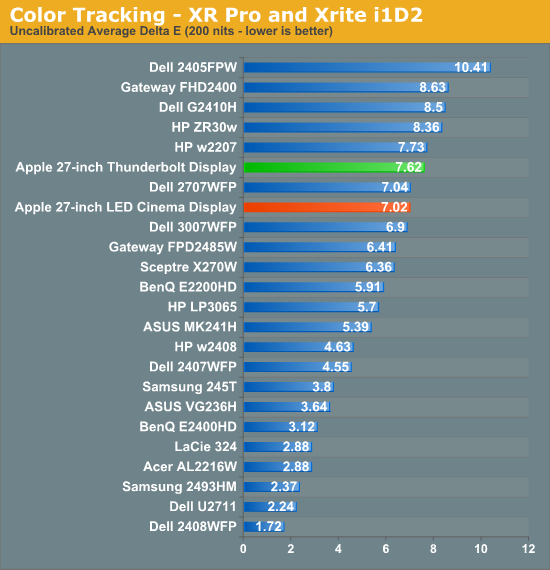
Uncalibrated performance remains fairly similar to last year's LED Cinema Display, however once calibrated the Thunderbolt Display is spot on with its predecessor:
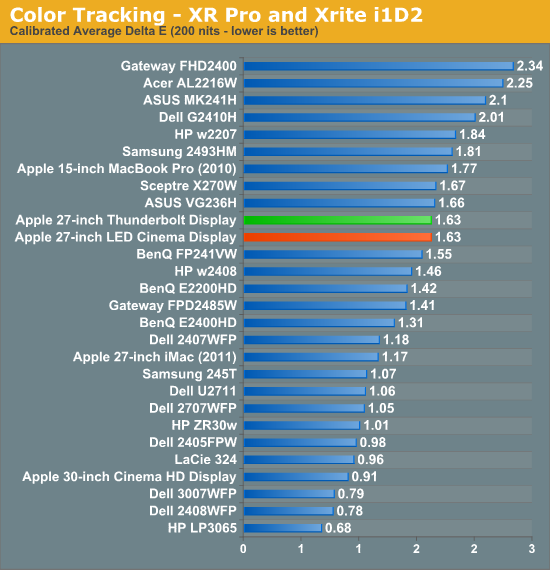
As we mentioned earlier, a sub 2.0 delta E is good enough for professional use. Although not perfect the Thunderbolt Display falls within that range for sure.
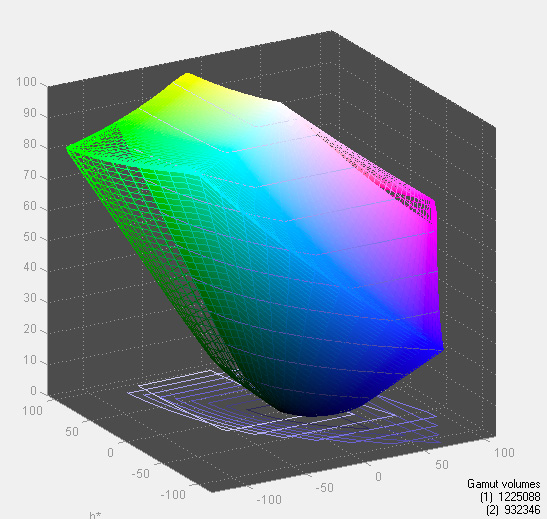
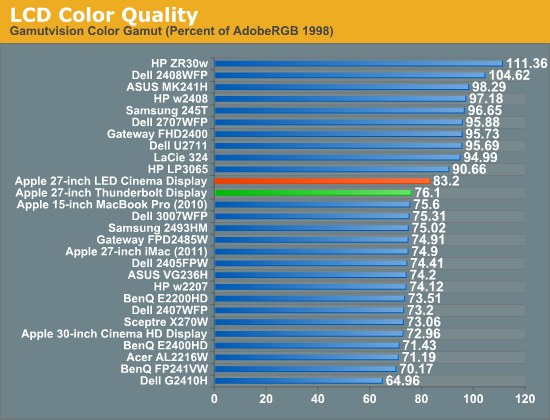
We measured slightly lower color gamut on the Thunderbolt Display than the original LED Cinema Display, however the result was much closer to the 2011 27-inch iMac. I couldn't visibly tell any differences and Apple indicates that color gamut shouldn't have changed, so it's quite possible that the differences here are due to our colorimeter and not the panel.
Color Uniformity
Now for color consistency, we take our best calibration profile from the very center at 200 nits and test color accuracy at 9 different places around the LCD display in an evenly distributed grid. We’ve shown before that calibration is localized across the display, partly due to the brightness not being uniform, partly due to the discrete nature of the display itself.
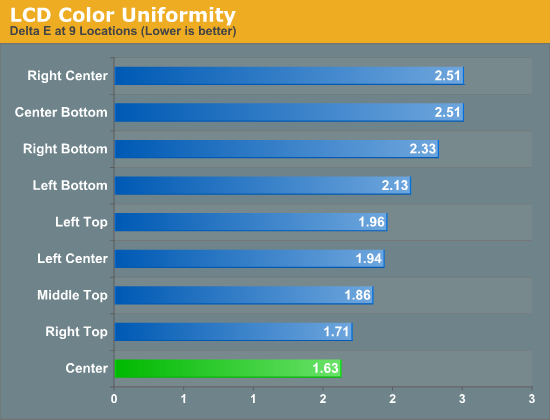
The Thunderbolt Display was fairly uniform across its surface, something we noticed in reviewing the 27-inch LED Cinema Display last year. Uniformity is actually better on this panel than the one we reviewed last year, although in both cases I couldn't really tell any differences.
Peak brightness appears down slightly, but so are the black levels which result in a slightly better contrast ratio. Apple is also calibrating these things at the factory now so white points are now set at around 6300K vs. 7100K on the original 27-inch LED Cinema Display.










275 Comments
View All Comments
doubledeej - Sunday, September 25, 2011 - link
I have many friends that work in "broadcast" and all but one of them lust after the Apple displays because they've got this silly notion that they are the best out there. No matter how many charts, spec sheets, reviews, etc., I throw at them, they refuse to believe that a Dell, Eizo, or anybody else could produce a monitor that performs better, especially if said monitor happens to be less expensive. There are an awful lot of Apple Kool-Aid drinkers out there, and nowhere is it worse than with video "professionals."seapeople - Friday, September 23, 2011 - link
My new Dell XPS 17 has an antiglare screen. Moderate progress?Dennis Travis - Friday, September 23, 2011 - link
Excellent review Anand as always. You covered everything I was curious about and more. Thanks again!HHCosmin - Friday, September 23, 2011 - link
want to say i just love your reviews Anand. i can tell you are passionate about what you do.this thing seems quite cool and it brings lots of help in cable clutter area. however i'm a pc guy and this is a mac. you talk about the future, and the possibilities. i've been thinking about this for some time now and getting really excited about the implications. i can see getting standard having monitors with thunderbolt and not much else to keep price down. link the display (through thunderbolt) cases that have sata ports and pciexpress ones. i call this a "slave box".
to have:
- laptop: slim, light, good autonomy (should be able to power this via display)
- display with thunderbolt, with ability to extend and not much extra
- a "slave-box" having psu, hdds, gpus and pciexpress slots for extras (no memory or cpu)
you get:
- use (and pay for) a single machine that you can carry around (with igp only)
- have practically no cable clutter
- get to feed power to the laptop through the monitor (when/if laptop maker standardize mobile bricks)
- have extra gpu/storage/sound etc when you are at home/office
- be able to upgrade the gpu
willmo - Friday, September 23, 2011 - link
Anand: I suspect that the Thunderbolt Display uses a Light Ridge controller, and the reason its DP output is not available for daisy-chaining is that it's used to drive the Thunderbolt Display's own panel.willmo - Friday, September 23, 2011 - link
Never mind, I hadn't gotten to the dissection yet. I assume the part number on the Thunderbolt controller checks out as Eagle Ridge...Ryan Smith - Friday, September 23, 2011 - link
Anand and I actually went back and forth on this. It's our belief that the display is being fed by LVDS, processed by some hereto unidentified controller on the logic board. You can see the ZIF cable connector on the following image, it's the gold colored component near the top-right: http://www.anandtech.com/Gallery/Album/1405#38ermhmm - Friday, September 23, 2011 - link
there is a product i'm not sure if its in production or whether you can use a GPU with it, but its similar to what you were talking about you can read about here. http://news.softpedia.com/news/Magma-Intros-PCI-Ex...as for gaming i'm in the UK and recently tried Onlive on my macbook and have to say i love the idea of cloud gaming solves the problem of expensive hardware for gaming.
efeman - Friday, September 23, 2011 - link
One small thing to point out: it looks like the wrong table was used in the "Testing the PIeces" section: it's listed as power consumption instead of something along the lines of transfer rates.I picked up the 4GB/128GB 11" Air a few days ago ($300 off!) for campus use; it does everything I need it to do in a great form factor. I was originally looking at a 14" unit, maybe a Lenovo E420s or T420s, but I haven't looked back. I have a self-built gaming desktop at home, yet the idea of a Thunderbolt future really intrigues me. While I don't ever see myself buying something like this display, I'm hoping to see cheaper storage solutions, and my fingers are crossed for external graphics support, as that's the only thing I'm missing on a unit like this.
Excellent review, as usual. I don't know if a video review has been done before, but I enjoyed it. The main points of the article in an easily-digestible form for those times that I don't want to read through paragraphs. I hope we see them in every review :-)
Off-topic: In case this post gets any attention, is there any chance the Macbook Air review can be updated with internal temperature data? I was disappointed to only see the surface and exhaust temperature info.
eXces - Friday, September 23, 2011 - link
love your video review! keep on excellent work!